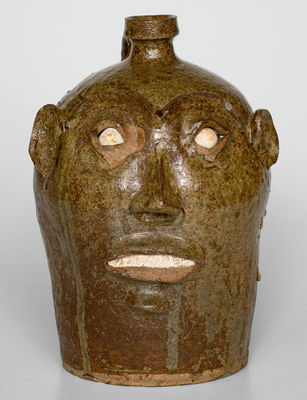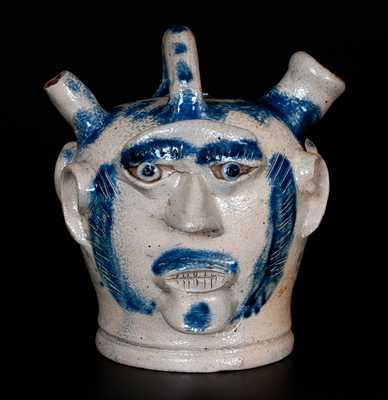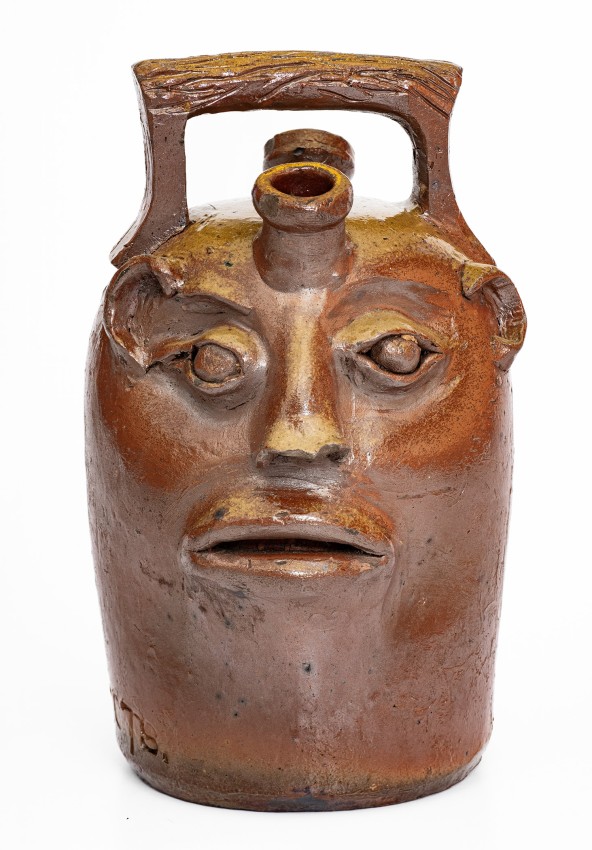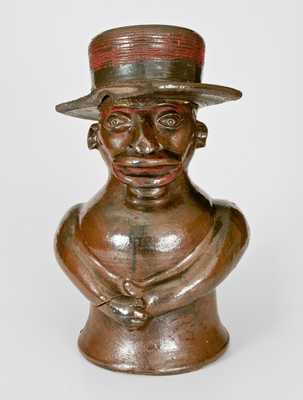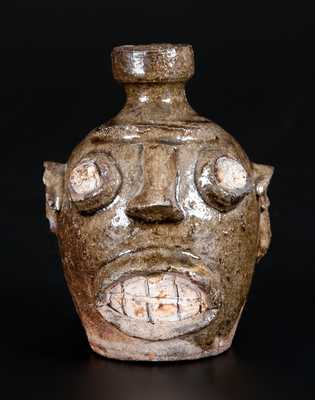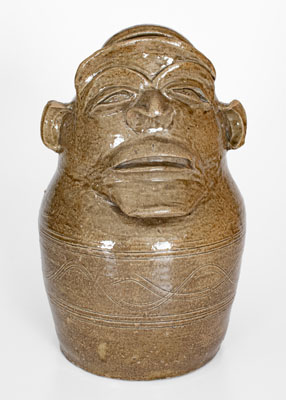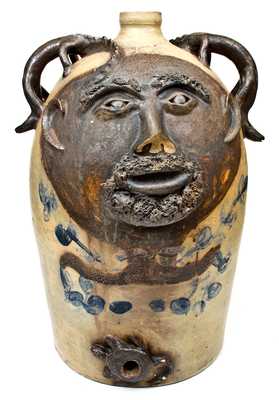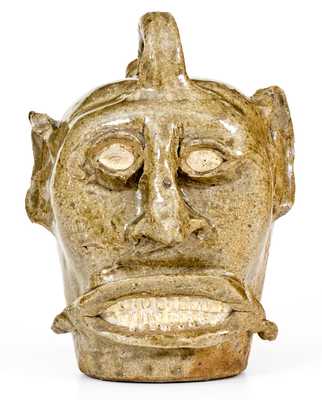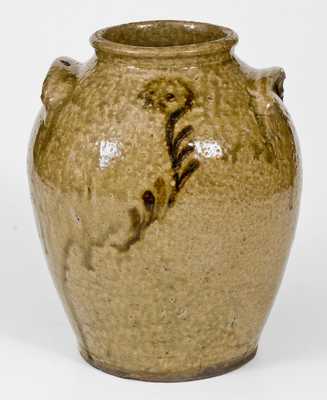Exceedingly Rare and Important Alkaline-Glazed Stoneware Figural Jug, Alabama origin, probably Randolph County, circa 1850-1875, wheel-thrown, ovoid jug in the form of a man's torso, surmounted by a tooled spout, the body and neck accented with paired lines of circumferential incising, the surface covered in a green alkaline glaze accented with flecks of iron. The figure's face includes an applied semi-lunate forehead, nose, ears, mouth with china teeth, rounded chin, C-scroll ears, and distinctive eyes with carved whites and glazed pupils. The use of a curved piece of applied clay for the forehead is compelling, as this treatment is most commonly associated with stoneware face vessels of the Mid-Atlantic and Northeast. The eyes exhibit an unusual construction, in which the jug was dipped in glaze and carved in a sgraffito-like manner around the pupils. The odd placement of one ear in its correct location (on the side of the head) and the other horizontally at the base of the head appears purposeful. While this asymmetry may have some as-yet-unknown meaning, the one ear's placement at the base of the head allows the jug to be handled easier around the neck. Potted in an impressive large size, measuring approximately three quarts to one gallon, this recently-surfaced work is one of the earliest Alabama face vessels known. Its form, glaze, and handle terminal construction, connect it to the state's Randolph County school, one which was strongly influenced by an influx of Edgefield-trained potters during the 1830s. The distinctive tooled banding throughout the figure's body is found on a number of utilitarian vessels by Bacon Level potters, including pieces by John Barnes and Zachariah T. Ussery. The jug's iron-flecked alkaline glaze, ranging from olive to celadon at the base, is exceptionally rare for such a piece, indicative of an earlier period of manufacture than the vast majority of other Alabama figural pieces known, which were typically glazed with Albany slip or salt over Albany slip. This face vessel is previously undocumented and entirely fresh-to-the-market, having descended in a Texas family to its current owner. Included with this lot is a late 19th or early 20th century photograph of the jug's prior owner, Israel Fuller (1833-1918), and his wife, Martha L. "Shug" Lee. The reverse of the photograph has a hand-written note, inscribed "Uncle Israel Fuller / Aunt Shug- sister to T.M. Lee / wher (sic) the old brown jug come from. Mike your Great Grand Daddy got it from uncle fuller". This vital information affords us the rare opportunity of helping to establish where and when the jug may have been acquired. Israel Fuller was born circa 1833 in Laurens County, South Carolina. By 1835, his family had moved to Georgia, settling in Meriwether County. Fuller married in 1860 in Carroll County, Georgia, but had arrived in Texas by the end of the decade; in the interim, he served in the Confederate Army as part of 19th Arkansas Infantry during the Civil War. After his wife's death in 1870, he married her sister, Martha L. "Shoog" Lee, who appears beside him in the photograph. Her father, Washington Woodson Lee, was listed as a blacksmith living in Heard County, Georgia, in the 1850 census. Two brothers were also blacksmiths, and they appear with their father in Carroll County, Georgia in the 1860 census. One of these brothers was Timothy M. Lee, the man referenced in the note on the photograph. Fuller would die in 1918 in Abilene, Texas, after moving around the state between 1870 and his death, and appearing in the following counties: Davis (1870, as a farmer), Parker (1880, as a merchant), and Runnels (1910, "own income," deriving income from some unspecified source). Fuller's marriage in Carroll County, Georgia, corroborates a Randolph County, Alabama, attribution, as the two counties border each other. As Fuller was living in Texas by 1870, it can be assumed the jug was acquired while he was moving west, sometime around his marriage date of 1860. This information supports the idea that the jug may be one of the earliest Alabama face vessels known, made prior to 1870, and possibly prior to 1860. Important in its form, size, origin, and glaze, this figural jug is made all the more significant by the inclusion of a family provenance. Provenance: A fresh-to-the-market example, which descended in the family of South Carolina, Georgia, and Texas resident, Israel Fuller (1833-1918). Missing handle. Two spout chips. A tiny chip to one ear. A small stone ping to front. Area of nose is unglazed. Photograph with staining and typical edge wear. H (of jug) 12 3/8". Dimensions (of photograph): 8" x 6". Dimensions (of image): 5 1/2" x 3 7/8".











